Infrared heaters from gas cartridges. Infrared gas heaters - pros and cons. Types of gas infrared heaters
For quick heating of the room during the cold season the best option are infrared gas heaters. If such devices are used outdoors, they increase the ambient temperature by 15 degrees on average.
Features of the device and principle of operation
An infrared heater warms interior objects and surfaces, not the air. Thus, the temperature of the room or open area rises very quickly.
The design of a gas heater includes a radiator, a gas cylinder, a chamber for mixing gas with oxygen, a burner, and a reflector - reflector. Most models are equipped with a protective system to prevent excess carbon dioxide concentrations. In addition, when tilted and the flame in the burner goes out, the device automatically turns off to avoid emergency situations.
Main types
The main type of gas separation infrared heaters by type of emitter: tubular and ceramic. The source of IR radiation is metal tubes, since it is in them that the gas is burned. Depending on the position of the reflector, all devices are divided into several types. In dome gas heaters, the reflector is located at the top and reflects radiation downward. Thus, a dome is created from warm air. Basically, such devices are used to heat outdoor areas. Directional devices have a side reflector, which creates sector heating.
Application of gas IR heaters
This type of heater was originally created for heating outdoor areas. These include verandas, terraces, gazebos, etc. These devices are often used for heating warehouses, production premises, country houses, cottages, garages. This is due to the compactness, efficiency of the devices and the absence of the need to connect to electricity. All gas infrared heaters should be used in a well-ventilated area.
Quite often there is a need for a heat source that can quickly create comfortable conditions in a cold room. Similar situations arise at the dacha during the cold season, as well as during fishing trips and other types of outdoor recreation, where people spend the night in a tent. Many dachas in the cold season are heated with wood or receiving coolant from boilers, but such heating systems are inertial. And in order to quickly get heat in country house, you need a fairly powerful source of infrared radiation.
Gas infrared heaters for summer cottages are one of the most efficient and convenient heaters.
Operating principle
In infrared heaters, the combustion gas is heated to a certain temperature, as a result of which infrared radiation appears in the thermoelement. In principle, such a heater is not very convenient as a main one. heating device in the rooms of the country house. The air is transparent to infrared rays and can only be heated by contact with objects in the room that have been heated by the thermoelement. But on the other hand, you can quickly create a heat source in the room, which makes it possible to warm up, regardless of the availability of electricity or firewood, which can get damp.
Gas cylinder as the basis of the emitter
Gas cylinders are used to heat the thermoelement. This design makes IR heaters mobile and allows you to quickly move them from one suitable location to another. IR heaters are especially convenient because they can be used in the yard. Moving the gas cylinder and the infrared heater itself does not cause much difficulty.
 There are no massive parts in the design of the infrared gas heater. Therefore, the gas cylinder can be small-sized specifically for the mobility of the heater as a whole. But for long work sufficient cylinder required large volume. Therefore, for the evening feast on outdoors and other similar events at the dacha there are industrial outdoor ones with large cylinders to create a powerful and long-lasting flow of infrared radiation.
There are no massive parts in the design of the infrared gas heater. Therefore, the gas cylinder can be small-sized specifically for the mobility of the heater as a whole. But for long work sufficient cylinder required large volume. Therefore, for the evening feast on outdoors and other similar events at the dacha there are industrial outdoor ones with large cylinders to create a powerful and long-lasting flow of infrared radiation.
In order to most accurately install such an outdoor gas radiator in order to best heat the surrounding space, gas from the cylinder enters the radiator through a hose. This allows you to move the lighter emitter within certain limits, leaving the cylinder in place.
Unfortunately, despite its convenience, a gas emitter when used indoors must be operated in compliance with the following safety measures:
- The room with a working gas emitter must either have good ventilation or be ventilated periodically. This is due to the fact that the combustion gas, heating it, enters the surrounding space after exhaustion. For this reason, the hot burnt gas will first rise to the ceiling and, as it cools, mix with the air in the room. At the same time, the amount of oxygen in the room will decrease. The combustion of any organic substance leads to the appearance of a certain amount of carbon monoxide, which quickly accumulates in the body and has a very negative effect on it. But carbon monoxide is removed from the body much longer than it accumulates. And if you operate a gas heater for a long time in this room, you can accumulate a dose of carbon monoxide sufficient to cause poisoning. For this reason, it would be correct to install a gas emitter under the hood in the room.
- You cannot operate a gas emitter without protective glass or a grill separating the thermoelement from the surrounding space. Heat The thermoelement will instantly ignite any flammable object upon accidental contact.
- When moving from place to place, the gas emitter must be turned off.
- When operating a gas emitter, it is necessary to exclude the possibility of it falling from a height or overturning.
- If you smell gas and it is discovered that the gas does not burn, you must first ventilate the room and only then put the gas emitter into operation.
There are models of emitters on sale that have special sensors installed that detect violations of the safety of the emitter. It is more correct to opt for such models when purchasing.
Homemade designs
However, it is quite simply designed. For this reason, instead of buying industrial models, many craftsmen will be able to make their own heater for a garage or a tent used, for example, for fishing, as well as an outdoor heater for a summer house.
The use of a gas radiator, both outdoor and in a tent and garage, reduces safety requirements, if only because the heater can operate both outdoors in the country and at the entrance of the tent and garage. Therefore, if there is a malfunction in the heater due to making it yourself, the consequences will not be as severe as when it is used in a residential area.
For a homemade gas emitter you will need the following basic components:
- Gas cylinder. The cylinder can be of any volume within the limits determined by the task. To heat a tent while fishing, it is advisable to use a lot of small disposable cylinders, intended for refilling lighters, and for the garage it is advisable to use a small refillable cylinder.
- Stainless steel bowl. It serves as a reflector to ensure the directionality of the radiation.
- Wire sieve from a colander. It will serve as a thermoelement. It’s even better to use several sieves that can be nested one inside the other to increase the heating surface. And the largest sieve will serve as a protective grid.
- Other details at your own discretion into a single design of a cylinder, bowl and sieve.
- For maximum compactness, the entire structure can be assembled directly on the body of the gas cylinder.
From the heater
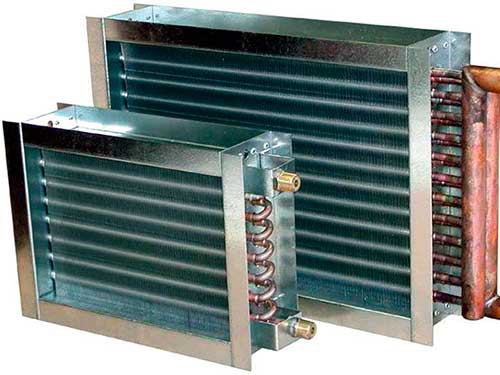 A good basis for making your own gas emitter for a tent and fishing can also be a faulty industrial model of a heater with a round mirror. In such an industrial heater, the spiral is placed on a ceramic base with a base, like a light bulb. Usually, either the spiral burns out quickly enough, or the contacts in the socket into which the base is screwed are damaged. You have to buy new parts to replace faulty parts, and the heater, of course, is not used. But if:
A good basis for making your own gas emitter for a tent and fishing can also be a faulty industrial model of a heater with a round mirror. In such an industrial heater, the spiral is placed on a ceramic base with a base, like a light bulb. Usually, either the spiral burns out quickly enough, or the contacts in the socket into which the base is screwed are damaged. You have to buy new parts to replace faulty parts, and the heater, of course, is not used. But if:
- remove the cartridge and ceramic base with a spiral with your own hands,
- buy several steel wire brushes designed for washing dishes,
- put them together and gently squeeze them with your hands,
- then place the compressed brushes inside the enclosure of the heater spiral, where they will elastically expand and fill the space inside the grate.
You will get an almost finished gas emitter, made by yourself. All that remains is to place the nozzle at the location of the cartridge, supply gas through it and set it on fire, adjusting the strength of the flame with your own hands.
To heat a tent, a small gas canister can be attached directly to the heater cartridge, and in the design of a gas radiator intended for heating a garage, use a hose to connect the nozzle to a gas cylinder of the required volume.
However, when using such an emitter inside a garage, you must be very careful, since the vapors of gasoline or other flammable substances can flare up from the flame of the burning gas.
From the chimney pipe
 A safer design of the emitter for heating a tent and garage from a small disposable gas cylinder can be made using a section of a stainless steel chimney. Such a heater will look like a miniature stove and will combine convection with thermal radiation. In this case, you can remove combustion products outside the tent or garage. To make such an emitter you will need:
A safer design of the emitter for heating a tent and garage from a small disposable gas cylinder can be made using a section of a stainless steel chimney. Such a heater will look like a miniature stove and will combine convection with thermal radiation. In this case, you can remove combustion products outside the tent or garage. To make such an emitter you will need:
- one section of stainless steel chimney pipe,
- several steel wire brushes intended for washing dishes,
- four pieces of steel wire with a diameter of 3 mm and a length 3-5 cm longer than the diameter of the pipe,
- a metal pipe of smaller diameter to remove combustion products,
- adapter for connecting pipes,
- flame splitter from a gas stove burner.
Required:
- make four holes in the pipe so as to insert two pieces of wire into them crosswise,
- bend the ends of the wire pieces so that they do not fall out,
- insert compressed pipe cleaners into the pipe and note the approximate volume that they occupy, resting against the pieces of wire,
- along the border of the pipe cleaners, make four more holes in the pipe so as to insert the two remaining pieces of wire into them crosswise,
- place a flame splitter over the brushes and secure the inserted parts with pieces of wire with bent ends,
- the holes must be located at such a distance from the end of the pipe that the pipe can be used to cover a gas cartridge placed on the floor,
- in order for air to pass inside the pipe and the gas to burn, there must be either a gap at the bottom, due to some kind of stand, or a cut along the edge of the pipe,
- To control the combustion of gas in the pipe wall opposite the flame zone, you need to make a cut with a grinder to make the flame visible.
Wire brushes and heated burner flames will give off radiated heat to the walls of the pipe, from which the surrounding air will heat up. In this case, the burner flame and the emitter will be reliably isolated by the pipe walls from the surrounding space.
Every city dweller strives to get away from the hustle and bustle for the weekend, breathe clean air and enjoy the beauty of nature. Dacha is the most best place for relax. Some city dwellers go to their dachas for the whole summer. In autumn and winter periods A year of pleasure from staying at the dacha is not enough, because not every dacha house has a stove or other heating device that can make the entire room warm.
With a gas heater, dacha owners will not have to worry that the cold will prevent them from having a good holiday. A gas heater can quickly and well heat a house and even warm up vacationers on the street. Some, hearing about this, may smile ironically and think that this is impossible. But, if you hear the reviews of those people who use these heaters, their opinion will change forever.
Characteristics and types of gas heaters
 Gas units are type of heating equipment, running on gas. The heater device includes the following parts and components: housing, heating pad, a heating element, heat exchanger, gas storage cylinder. Sometimes, for convenient use, units are equipped additional elements: thermostat, control device using a special program, ignition or automatic shutdown to stop the gas supply, etc.
Gas units are type of heating equipment, running on gas. The heater device includes the following parts and components: housing, heating pad, a heating element, heat exchanger, gas storage cylinder. Sometimes, for convenient use, units are equipped additional elements: thermostat, control device using a special program, ignition or automatic shutdown to stop the gas supply, etc.
According to the method of heat transfer, gas heaters are:
- convectors
- catalytic devices
- infrared heaters.
Convectors
They have open and closed camera view. Difference: closed-type devices have a coaxial tube. The average power of convectors is about 4 kW. They easily heat rooms of 40 sq.m. Closed type convectors are more practical to use, since combustion products do not enter environment(room).
The advantages of the convector are efficiency, fast heat transfer, compactness, flameless heating, etc. Disadvantages: more complex installation, it is necessary to make a hole in the wall for coaxial pipe In order to ensure the removal of combustion products, inertia (fast heating and cooling), it is also necessary to provide a through passage for the gas supply pipe.
Catalytic devices
These devices operate on gas and its optimal heating area is about 20 square meters . The average power of the device is about 3 kW. The device has a fan. Propane-butane gas burners operate through catalytic combustion without the formation of a flame. In the air, the process of oxidation of certain types of inorganic substances occurs. As a result of combustion, it releases thermal energy. By color (yellow or crimson) you can determine the degree of heating of the catalyst. Coefficient useful action about 80%.
In Russia, catalytic devices have not become as widespread as in Europe. The design of catalytic devices is mobile and, thanks to the presence of wheels, can be easily moved to any place. The catalytic panel is made of glass fiber.
Infrared heaters
The most convenient for heating country houses is infrared gas heater, it works autonomously and is easy to move. This type of heaters has become most widespread in Russia due to its operating principle and performance properties.
Operating principle of an infrared heater
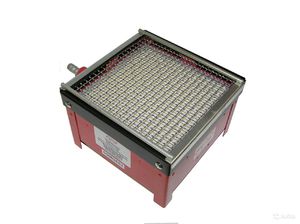 Heating rooms with an infrared heater like the warmth of the gentle rays of the sun. When it's cold outside, the sun heats the objects that its rays hit. The gentle rays of the sun bring only pleasant sensations. Also, infrared radiation, when directed at things, heats their surfaces without heating the air. Objects heated by radiation give off their heat to everyone around them.
Heating rooms with an infrared heater like the warmth of the gentle rays of the sun. When it's cold outside, the sun heats the objects that its rays hit. The gentle rays of the sun bring only pleasant sensations. Also, infrared radiation, when directed at things, heats their surfaces without heating the air. Objects heated by radiation give off their heat to everyone around them.
The operating principle of infrared gas heaters is as follows: the device contains a gas burner that heats a special element made of ceramic. When the temperature increases, it emits rays of infrared light. Thus, everyone knows that radiation heats the surfaces to which it is directed, but the air does not heat. With help of this property Most of the energy obtained as a result of natural combustion goes to heating the room, and therefore the room quickly becomes warm.
Advantages and disadvantages
Heaters are a powerful and unpretentious means with which you can warm up in the countryside and not freeze even in winter, when outside subzero temperature air. The infrared units have been developed specifically for use in country houses. They have some important advantages:
- Compact and convenient shape. These thermal heaters can be transported in the trunk of any car. They can also be carried in small travel bags, which is convenient when you need to frequently move from one place to another. Some dacha owners do not want to leave these devices in the house and take them to the city.
- The country house will always be warm, as these heating devices provide good heating even when there is no electricity.
- This device can be used both inside the house and outside near the barbecue or on the veranda.
- Reliability and safety of use, subject to compliance with the factory instructions and safety regulations for gas cylinders.
Along with the advantages, there are some disadvantages, compiled from user reviews:
- When these devices operate, gas combustion occurs, which consumes oxygen, and carbon monoxide stands out. Therefore, in the room where the gas heater is located, it is necessary to install powerful ventilation or ensure it through constant ventilation.
- To ensure safe operation of heaters, it is necessary to purchase and subsequently charge gas cylinders only from official suppliers.
- When assembling and installing these units, you must strictly follow the instructions. If you do not have enough installation skills, it is better to seek the help of a specialist.
User reviews
 When purchasing an infrared device, you must get expert advice, as well as read the positive and negative reviews of people who purchased and use these devices. It is always useful to hear their feedback, since in the store you will not find a consultant who, along with the advantages, will truthfully report all the shortcomings of the device. Sometimes they just don’t know about it, because they don’t use heaters at home.
When purchasing an infrared device, you must get expert advice, as well as read the positive and negative reviews of people who purchased and use these devices. It is always useful to hear their feedback, since in the store you will not find a consultant who, along with the advantages, will truthfully report all the shortcomings of the device. Sometimes they just don’t know about it, because they don’t use heaters at home.
There are many specialized forums and websites where users write their reviews about products. Here are some reviews from users of infrared gas heaters:
Gas convector 3 kW.
For a long period of time, my friend heated his dacha using a 2500 W heat fan, which stood in one room during the cold season and warmed everyone present. It was cold in winter and this fan was not enough to warm the room. Then he bought gas convector on propane, installed an exhaust pipe on the street, even in winter it became warm. This device, with a power of about 3000 W, warms up the room so well that you can spend the night in the country even in winter.
Vladimir, Novgorod
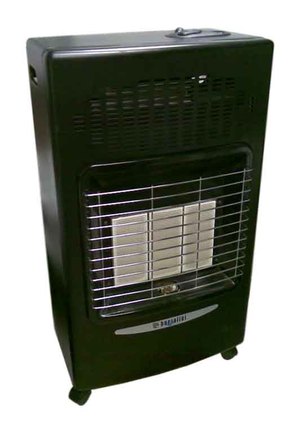 We purchased it about two years ago when we needed to constantly heat our country house. Before this we used electric convectors. But in winter, this type of heater is uneconomical, and it’s good to heat the room electrical appliances impossible. Stationary heating was not planned. That's why we bought a gas heater small sizes, having a metal body and coated with heat-resistant enamel. The weight of the cylinder is about 10 kg, so when summer comes I can take it to the second floor myself, and when it’s cold I can lower it to the bottom. There are two convenient handles on the sides.
We purchased it about two years ago when we needed to constantly heat our country house. Before this we used electric convectors. But in winter, this type of heater is uneconomical, and it’s good to heat the room electrical appliances impossible. Stationary heating was not planned. That's why we bought a gas heater small sizes, having a metal body and coated with heat-resistant enamel. The weight of the cylinder is about 10 kg, so when summer comes I can take it to the second floor myself, and when it’s cold I can lower it to the bottom. There are two convenient handles on the sides.
Another advantage is its efficiency; it is cheaper to heat a house with this device than with an electric one. Of the minuses: it is difficult to “ignite” it, so the ceramic plates do not immediately flare up. The second disadvantage is the smell of gas, especially when it is just warming up. Then the smell disappears. I advise you to use this heater for heating summer cottage areas of no more than 30 square meters. m. For constant use for a whole year, I do not recommend it. I used the heater for 2 years.
Natasha, Penza
I have been using the heater for 1 year. Very pleased with the work. I use it for heating country house. Little gas is consumed, so the efficiency of the unit is good. Fast and active heat transfer. The device can be conveniently transported to any place. Can be used even when there is no electricity in the house.
At first I was afraid of getting burned. But I realized that this is unrealistic, since in any operating mode of the device carbon dioxide released in a volume that is safe for life. For safe use, it is enough to carefully study the instructions and follow them carefully. I am satisfied with the performance of the heater.
Igor, Moscow
Infrared gas heater
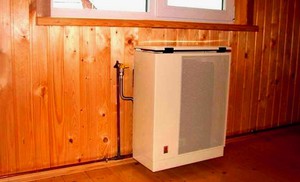 I’ve been using it for 5 years, when our dacha community started turning off the electricity in the fall. At first we heated ourselves with a potbelly stove, and then an employee at work advised us to buy an infrared gas heater. We have been using it for five years now and are very pleased, since firewood for heating a potbelly stove in winter is not always easy to find. It's easier to take a bottle and fill it with gas. The only downside is that you can’t leave it unattended overnight. gas unit. In the evening we heat the room well, it lasts until the morning.
I’ve been using it for 5 years, when our dacha community started turning off the electricity in the fall. At first we heated ourselves with a potbelly stove, and then an employee at work advised us to buy an infrared gas heater. We have been using it for five years now and are very pleased, since firewood for heating a potbelly stove in winter is not always easy to find. It's easier to take a bottle and fill it with gas. The only downside is that you can’t leave it unattended overnight. gas unit. In the evening we heat the room well, it lasts until the morning.
Nikolay, St. Petersburg
Heater Italian Pullove
I wanted to buy a heater. I looked closely for a long time and the choice fell on the Italian Pullove. Branded assembly and beautiful appearance. Another advantage is that the gas cylinder is completely covered with a plastic box. The power of the unit is sufficient. Therefore, a house of 30 square meters warms up quickly. One charged cylinder lasts for 10 years. I am very pleased with the use of this device and recommend it to everyone.
Sergey, Moscow
After reading reviews from regular users of gas heaters, we can conclude that there are more pros than cons. If you choose a heater of a proven brand with the required power, you can easily heat the desired area quickly and economically. When choosing, you need to give preference to the gas heater model that has the most positive reviews.
Heating devices such as gas infrared heaters are used to heat open areas, semi-enclosed areas, industrial and residential premises. Their essence is to generate infrared radiation, which warms up surrounding objects, transferring some of the heat to them. Infrared heaters were developed specifically for this purpose, operating from the main or liquefied gas. This is the topic that our review will be devoted to.
IN this material we will talk about:
- installation of gas infrared heaters;
- their principle of operation;
- operating features infrared systems heating;
- their advantages and disadvantages.
Features and principle of operation of the gas IR heater
Heating equipment warms in two ways - thermal (infrared) radiation and by heating the air. The first method is used in gas infrared heaters, which are actively used for heating open areas and rooms for various purposes. They heat not the air, but the surrounding objects, creating warm and comfortable conditions for people to stay for a long time.
Gas infrared heaters are most often used for heating outdoor areas, but nothing prevents them from being used for heating indoors. If you like to have evening gatherings with tea in the open air or on the veranda, then this unusual equipment will be a pleasant gift for you. It will create a warm zone in which adults and children will be comfortable.
Infrared heating devices running on gas will become indispensable for heating areas with swimming pools, industrial premises, summer verandas, open areas of street cafes, sports grounds and residential premises. The powerful infrared radiation created by these devices will quickly warm up surrounding objects and warm people, consuming a minimal amount of gas fuel.

The design and principle of operation of a gas infrared heater.
How do gas infrared heaters work? Inside them we will find:
- burners with ignition system;
- emitters - they generate heat;
- control circuits - they regulate the gas supply.
The task of a gas infrared heater is to generate infrared radiation. For this purpose, ceramic and metal elements, warming up under the influence open flame. When heated, they become a source of thermal radiation, heating surrounding objects.
To form a specific impact zone, some models are equipped with reflectors that ensure the directionality of infrared thermal radiation.
The infrared radiation generated during operation warms up surrounding objects, causing them to begin to give off heat. It can be felt even at a distance of several meters, allowing you to heat large spaces. For increasing efficiency some models use additional fans that increase the intensity of the flame.
Due to their design and operating principle, such models are used for heating restaurant terraces, open courtyard areas, summer verandas, as well as residential and industrial buildings.
As already mentioned, heat is generated by burning gas - it is stored in built-in or connected cylinders. One refill, depending on the power of the burner and the capacity of the cylinder, can last for 10-15 hours continuous operation. Due to the fact that gas combustion is carried out in open form, heaters are installed only in well-ventilated areas.
If you plan to heat rooms with such a device, do not forget to open the windows - combustion products (not very many of them are formed) should be freely removed outside through a natural draft.
Infrared gas heaters - pros and cons
Infrared gas heaters, like any heating equipment, have a number of advantages and disadvantages. First, we will look at their positive features and find out why they are so good:
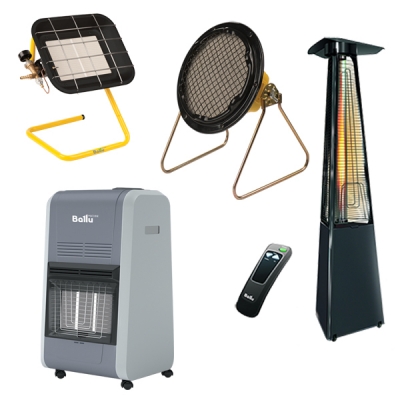
Despite the variety of models of IR heaters, all of them can be installed both at home and outdoors.
- autonomous work – such devices operate only on gas and do not require connection to electrical network (this applies to the vast majority of models);
- low noise level - despite the presence of burners, the noise level generated during fuel combustion remains extremely low;
- compact dimensions – thanks to their small dimensions, gas heaters can be easily transported from place to place without any effort;
- versatility in use – gas devices can be used to heat rooms and open areas;
- the ability to work in areas where there is no main gas pipeline - you can connect/install a cylinder and power the device from it;
- high degree of fire safety - despite the fact that it gas equipment, it is safe. There is no need to be afraid of fires;
- no release of toxic substances - when gas is burned, water vapor and carbon dioxide are formed;
- efficient heating of open areas – No other heating equipment can do this;
- fast heating - ensured by the effective generation of infrared radiation.
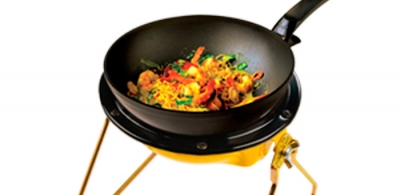
For lovers of hiking and picnics, an undoubted advantage is that you can even cook food using IR heaters.
Gas infrared heaters perfectly warm rooms and open areas, are easily connected to gas sources, do not require permitting - they can be purchased and safely used without asking anyone for permission.
Some people use them not only for heating, but also for technical needs - for example, for drying some things and objects, as well as for eliminating ice and warming up rooms after a long period of idleness in frosty conditions (relevant for dachas).
- the need for good ventilation - arises when using such devices indoors;
- operating rules must be strictly followed- despite fire safety, it is still necessary to comply with safety regulations and caution in use;
- it is impossible to use where there is no gas - if in your area there is no opportunity to purchase bottled gas, the operation of the heaters will become difficult. Whatever you say, electrification in our country is more widespread than gasification.
Despite the presence of certain disadvantages, home and outdoor heaters continue to be in demand among consumers.
Types of gas infrared heaters
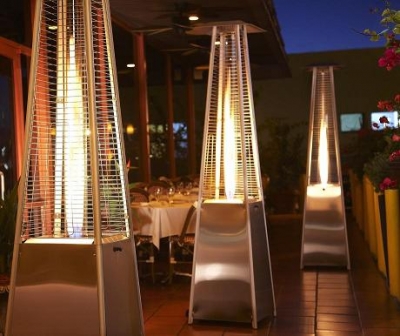
Outdoor gas infrared heaters great choice for outdoor restaurants, gazebos and verandas.
There are many types of IR heating devices available for consumers to choose from. On sale are catalytic models, portable, outdoor, universal, industrial, country and many others. Let's look at the most popular varieties and find out their characteristic features.
An outdoor gas infrared heater is a heating device for outdoor use. Comes with legs for floor installation or itself has a floor structure. The greatest demand is for special street models equipped with umbrellas. They allow you to form a uniform circular heating zone within a radius of several meters. Such devices operate from built-in or plug-in cylinders.
The greatest ease of use is shown by street models in the form of tall columns - they provide a good distribution zone of infrared radiation aimed at people and objects around them.
Gas infrared heaters for summer cottages are compact devices that easily fit into a small box. They are manufactured in a floor-standing design and are small in size. Some of them do not have legs; such models are installed on the floor or on the ground. Country heaters are used for heating residential and utility rooms, as well as for heating open areas (yards, barbecue areas, terraces and verandas).
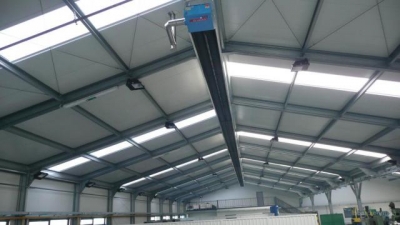
Ceiling industrial models are capable of maintaining heat in large rooms.
Industrial gas infrared heaters are different large sizes and high performance. They burn a large number of fuel, requiring good ventilation for its operation. Also on sale are ceiling models, somewhat similar to fluorescent lamps, but larger in size. They are used for heating utility and industrial premises, as well as for complex heating of warehouses.
Ceramic gas infrared heaters powered by a cylinder are compact models universal application. They are used to heat buildings for various purposes and open areas. Almost all models on sale are made on the basis of ceramic generating elements.
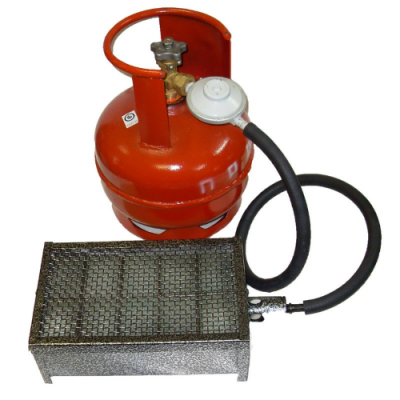
Compact gas infrared heaters are used to heat tents and small rooms. They are built on the basis of small-sized burners that provide heating of small volumes. Such devices are powered from small-sized gas cylinders. When using compact models, it is necessary to ensure high-quality ventilation - it has virtually no effect on the degree of heating.
Catalytic gas infrared heaters are designed according to an unusual principle - here heat is generated using chemical reaction on gas oxidation. There is heat in such devices, but there is no flame. Thanks to this, they can be safely used for heating living quarters and tents, requiring virtually no ventilation. Compact gas catalytic heaters are in demand among summer residents and tourists.
Which gas IR heater is right for you?

Do you want to buy a gas infrared heater for your cottage, home or open area? There are a lot of models on sale, and it’s easy to get confused in this abundance. We can recommend you the following model - IR heater Ballu BIGH-55 from the Galaxy2 series. The device combines infrared and convection operating principles. Power is supplied from plug-in and built-in (up to 27 liters) cylinders.
For use in outdoor conditions, we recommend purchasing tall models that resemble a column, or Street light with umbrella reflector. This device will create a circular heating zone, giving warmth to people and surrounding objects. Such devices can be used in any weather - an excellent choice for restaurants with open terraces and for lovers of evening tea at the dacha or veranda.
For industrial use, we recommend taking a closer look at ceiling gas heaters. They provide even heating large area With minimal consumption gas Similar devices are used for heating production workshops, utility rooms and warehouses.
Do you need a universal gas heater for any operating conditions? Pay attention to compact, small-sized models with connected gas cylinders. They have minimal dimensions and are characterized by good performance. Such models are useful for heating country houses, private households, utility rooms, as well as for heating small open areas.
Video
Gas infrared heaters can be divided into 2 large groups: street and indoor.
Outdoor ones are designed for installation on open verandas, terraces, summer cafes or just on the street. A powerful flow of heat comes from them, almost like from the sun, which creates the effect of heat. It's almost like the bright sun on a sunny spring day. The air temperature may be low, but you can take off your outer clothing and you will be warm. Structurally, outdoor infrared heaters can be made either in the form of a “mushroom” or “umbrella” where the cap plays the role of a reflector from which heat spreads in all directions, or in the form of a directional reflector or reflectors from which heat spreads in one direction.
In home gas infrared heaters, as a rule, you will not see an open flame. Flame from gas burner inside the case it heats a steel or ceramic radiator, from which, infrared heat extends beyond the body and heats surrounding objects. Such heaters, as a rule, are noticeably more powerful than electric ones and are capable of heating large areas cheaply and quickly, but they have one very significant drawback. The entire combustion process takes place indoors. These heaters directly burn large quantities of the oxygen we breathe. Therefore, the room where the gas heater is installed must be very well ventilated; such heaters cannot be left running unattended at night.
How do gas infrared heaters work?
The heat source in gas heaters is combustible propane-butane gas. When gas burns, a lot of heat is released, which allows the heater to heat large areas. Gas is supplied to gas cylinders, the same as those used for suburban gas stoves, only with a volume of no more than 27 liters. The cylinders are reusable. When the gas runs out, the cylinder should be refilled at a gas station or exchanged for a refilled one at a special exchange point. ATTENTION! The cylinder is not included with the heaters.
In outdoor heaters, as a rule, you can see a direct flame from the burner, the heat from which is directed in the desired directions using a reflector.
In home heaters, the flame is usually not visible. It heats a special metal or ceramic reflector, which, in turn, heats up and gives off heat to surrounding objects.
In our store you can buy ceiling heaters the best manufacturers at factory prices. Our managers will professionally advise you and help you decide on the optimal heater model for you.
